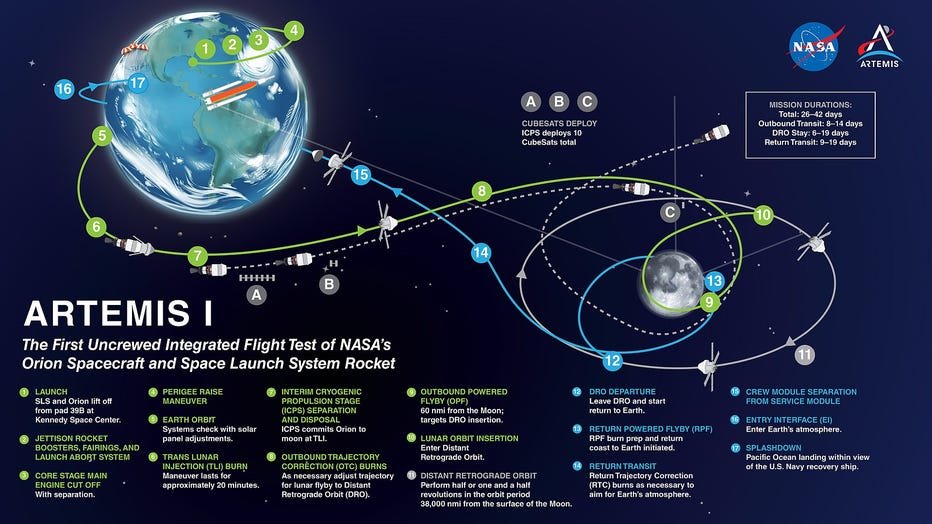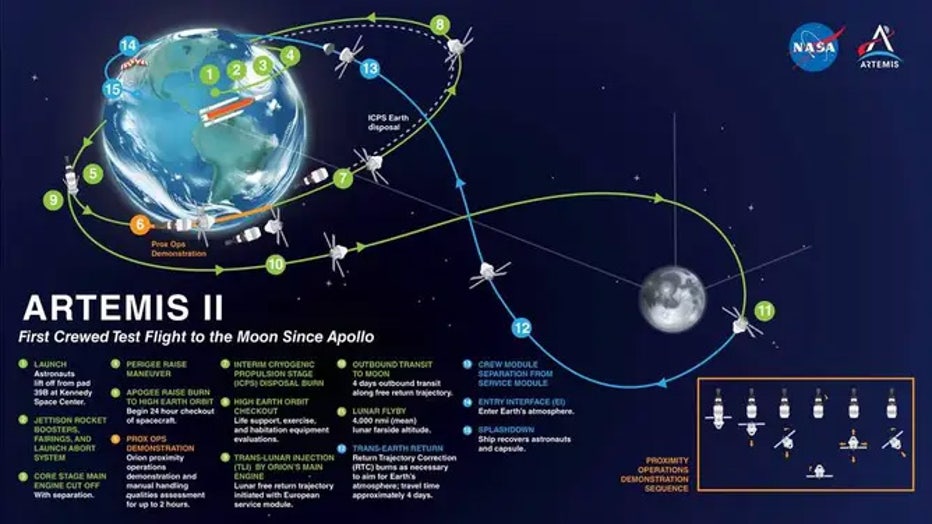Artemis 1: Everything you need to know about NASA’s moon mission

Artemis I launch scrubbed over technical issues
The Artemis I launch was scrubbed Monday because of technical issues. The next launch windows are Sept. 2 and 5, 2022.
NASA is gearing up for its historic Artemis 1 mission in which the first rocket in 50 years designed to carry humans back to the moon will lift off from the Kennedy Space Center in Florida.
It will be the first test flight of NASA’s Space Launch System (SLS) rocket and the Orion spacecraft and humans will not be aboard.
NASA said the Artemis 1 mission will demonstrate the performance of both Orion and the SLS rocket and test our capabilities to orbit the moon and return to Earth safely. The flight will pave the way for future missions to the lunar vicinity and beyond.
WHEN WILL ARTEMIS 1 LAUNCH?
The next potential launch window is available on Friday, Sept. 2. NASA had to scrub the Aug. 29th attempt from the Kennedy Space Center launchpad 39B due to technical issues.
A backup opportunity will be available on Labor Day on Sept. 5. Whether the rocket launches on either of those still depends on resolving the issue with one of the RS-25 engines, which could require NASA to roll the moon rocket back into the Vehicle Assembly Building for repairs.
At this time, the next availability for launch would be 12:48 p.m. ET on Sept. 2 or 5:12 p.m. ET on Sept. 5.
The test flight will last 42 days and send Orion on an extended moon orbit, before splashing down in the Pacific Ocean off the coast of California on Oct. 10, at a return speed of up to 25,000 mph.
HOW CAN I WATCH THE ARTEMIS 1 LAUNCH?
In-person: Spectators can to watch the Artemis 1 launch at some of the most popular viewing locations, including Space View Park in Titusville, Jetty Park in Cape Canaveral and along the beaches in Brevard County.
Livestream: FOX 35 will broadcast the launch live on Good Day Orlando and stream the launch live on FOX35Orlando.com and the FOX 35 News app:
WHERE WILL ARTEMIS 1 GO? LAUNCH AND MISSION TIMELINE

Artemis I mission [Credit: NASA]
The mission is to complete a lunar orbit, traveling a distance of about 280,000 miles from Earth around the moon. After launching from Kennedy Space Center, the SLS will send the Orion spacecraft on a trajectory to orbit the moon.
"Once they launch that vehicle and unleash the 8.8 million pounds of thrust. We'll start our journey," explained Judd Frieling, Artemis 1 ascent & entry flight director. After the SLS clears the KSC launch tower, the rocket will roll in a direction to bring Orion to a "heads down position," according to Frieling.
The vehicle will experience maximum dynamic pressure one minute into the flight, the point when the most physical strain is on the rocket.
MORE: Mission overview of NASA's historic moon rocket launch
SLS’s final job will be when the upper stage completes the translunar injection orbit maneuver around 1 hour and 20 minutes into the flight. The 18-minute engine burn will send Orion on its way to the moon.
On the way to the moon, Orion will deploy a handful of CubeSats, said Rick LaBrode, lead Artemis I flight director. The spacecraft will complete a series of trajectory correction burns on the first day in orbit. One of those burns will ensure the spacecraft moves ahead of the rocket's upper stage and the CubeSats eliminating any potential threat.
"We should get to the moon somewhere on the order of two and a half hours before the satellites, and the upper stage do," LaBrode said.

Artemis 1 timeline during Orion's lunar orbit. [ICredit: NASA]
Flight director: 'We'll be praying and hold our breath'
Another correction burn will get Orion about 60 miles from the lunar surface, sending it on a flyby of the moon. An expected communication blackout on the other side of the moon will be a nail-biting moment for everyone involved.
"Orion will be on the other side of the moon, and we won't have we won't have (communications) with it," LaBrode said."So we'll be praying and hold our breath."
When the spacecraft loops back around to orbit the moon, it will have traveled about 40,000 miles beyond the far side of the moon, which is farther than any human-rated spacecraft has journeyed before. This is known as the distance retrograde orbit or DRO.
Orion will spend about two weeks in orbit before beginning the journey back to Earth. Orion will complete a series of engine burns on the way back to Earth. About a week before it enters Earth’s atmosphere, the spacecraft will complete the most crucial maneuver of the journey home, the return power flyby (RPF) burn.
"That is our most critical burn of the mission. If something happens that one and we don't execute it, then it's a loss of the Orion capsule," LaBrode said. "We have to do that one, but we plan accordingly."
The RPF will set Orion up for the return coast to Earth before another burn angles Orion for Earth's atmosphere reentry.
There are two expected communication blackouts during reentry due to plasma heating the spacecraft.
At about 24,000 feet, three small drogue parachutes will deploy from Orion, followed by the main parachute at 6,800 feet. Eleven total parachutes deploy, slowing Orion from 350 mph to about 20 mph for landing. At 1,500 feet, Orion will roll to hit the waves at the proper angle.
Orion is set to splashdown off the coast of San Diego, where U.S. Navy recovery teams will be waiting.
MANIKINS WILL BE ABOARD ARTEMIS 1
Three manikins named Campos, Helga and Zohar will be along for the journey, outfitted with sensors to help determine what human astronauts will experience when they launch and land in Orion. Helga and Zohar will be seated in the two lower seats on Orion and Zohar will be wearing a vest designed to reduce exposure to radiation. Another experiment using the manikins will measure the amount of radiation astronauts may experience inside Orion.

Artemis I launch: Meet the manikins hitching ride on NASA?s moon rocket
When NASA launches its Artemis I moon rocket with the Orion spacecraft, humans will not be aboard, but scientists will be focused on three manikins who will be collecting important data during the multi-week excursion.
ARTEMIS 2 WILL HAVE A CREW. WHEN WILL IT LAUNCH?
While Artemis 1 will not have any humans aboard, the Artemis 2 mission is expected to launch a crew of four astronauts from Kennedy Space Center. The Artemis 2 mission will be the first crewed test flight to the moon since Apollo 17 in 1972.
The astronauts will journey in a hybrid free return trajectory and spend their time verifying spacecraft system performance in the space environment.

Artemis II: Astronauts on their first flight aboard NASA’s Orion spacecraft will travel farther into the solar system than humanity has ever traveled before. (NASA)
NASA’s chief astronaut, Reid Wiseman, says that the first crewed flight will be an essential step in returning to the moon and future missions to Mars.
"Artemis 1 leads to Artemis 2, which leads to Artemis 3, when we hope to have humans on the surface of the moon. But Artemis 1 is leading to the rest of the Artemis program. The first woman, the first person of color on the surface of the moon and then the first humans tracking out to Mars and putting our footsteps and building science laboratories and inhabiting another planet," Wiseman said. "It’s just the most awe-inspiring moment that we’ve had here at NASA."
Artemis 2 will be the second scheduled mission of the Artemis program and is expected to launch in 2024.

